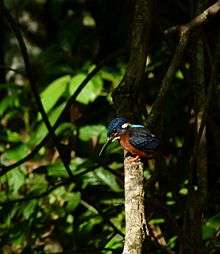Blue-eared kingfisher
| Blue-eared kingfisher | |
|---|---|
 | |
| Scientific classification | |
| Kingdom: | Animalia |
| Phylum: | Chordata |
| Class: | Aves |
| Order: | Coraciiformes |
| Family: | Alcedinidae |
| Subfamily: | Alcedininae |
| Genus: | Alcedo |
| Species: | A. meninting |
| Binomial name | |
| Alcedo meninting Horsfield, 1821 | |
The blue-eared kingfisher (Alcedo meninting) is found in Asia, ranging across the Indian subcontinent and Southeast Asia. It is found mainly in dense shaded forests where it hunts in small streams. It is darker crowned, with darker rufous underparts and lacking the rufous ear stripe of the common kingfisher (Alcedo atthis) which is found in more open habitats. A number of subspecies have been described that differ in measurement and colour shade. Adult males have an all dark bill while females have a reddish lower mandible.
Description

This 16 centimetres (6.3 in) long kingfisher is almost identical to the common kingfisher (Alcedo atthis) but is distinguished by the blue ear coverts, darker and more intense cobalt-blue upperparts with richer rufous under parts. The juvenile blue-eared kingfisher has rufous ear-coverts as in the common kingfisher but it usually shows some mottling on the throat and upper breast which disappears when the bird reaches adulthood. Young birds have a reddish bill with whitish tips.[2][3]
Taxonomy
Several plumage variations in the population that occur across its wide distribution range have been recognized as subspecies. These include:[4][5]
- A. m. coltarti Stuart Baker, 1919 - Indian subcontinent, Myanmar, Thailand and Indochina and includes laubmanni Mathews, 1925 of eastern India
- A. m. phillipsi Stuart Baker, 1927 Sri Lanka which are said to be larger and darker blue. Some authors restrict this to the Sri Lankan population while some older authors extend its range into the southern Western Ghats of India.
- A. m. rufigastra Walden, 1873 Andaman Islands which is greener on the upper blue parts.
- A. m. scintillans Stuart Baker, 1919 southern Burma and Thailand
- A. m. verreauxii De La Berge, 1851 Malaysia to Riau Archipelago east through Borneo and the Sulu Islands.
- A. m. meninting Horsfield, 1821 Islands off the west coast of Sumatra, Java, Lombok, Sulawesi, Banggai and Sula Islands.
Some other subspecies callima, subviridis and proxima are not considered to be distinct enough.
Distribution and habitat
| Measurements | |||
|---|---|---|---|
| Nominate[6] | |||
| Culmen | 35–48 mm (1.4–1.9 in) | ||
| Wing | 65–71 mm (2.6–2.8 in) | ||
| Tail | 29–31 mm (1.1–1.2 in) | ||
| coltarti[2] | |||
| Culmen | 34–36 mm (1.3–1.4 in) | ||
| Wing | 65–66 mm (2.6–2.6 in) | ||
| Tail | 26–27 mm (1.0–1.1 in) | ||
| Tarsus | 7 mm (0.28 in) | ||
The range of this species stretches from India in the west, eastwards across Nepal, Bhutan and Bangladesh, and further into Myanmar, Thailand, Cambodia, Vietnam and Malaysia. The usual habitat is pools or streams in dense evergreen forest and sometimes mangroves, situated under 1,000 metres (3,300 ft) of altitude.
Behaviour and ecology
The blue-eared kingfisher is largely resident within its range. They usually perch on branches overhanging densely shaded streams before diving below to capture prey that includes crustaceans, dragonfly larvae and fish. Other insects including grasshoppers and mantids have been recorded.[7]
The breeding season in India is mainly May to June in northern India and January in southwestern India. The nest is a metre long tunnel in the bank of a forest stream where about five to seven white near spherical eggs are laid.[2]
References
- ↑ BirdLife International (2012). "Alcedo meninting". IUCN Red List of Threatened Species. Version 2013.2. International Union for Conservation of Nature. Retrieved 26 November 2013.
- 1 2 3 Ali, S & S.D. Ripley (1983). Handbook of the Birds of India and Pakistan. Volume 4 (2nd ed.). New Delhi: Oxford University Press. pp. 78–80.
- ↑ Baker, ECS (1927). The Fauna of British India including Ceylon and Burma. Birds. Volume 4 (2nd ed.). London: Taylor and Francis. pp. 254–258.
- ↑ Peters, James Lee (1945). Check-list of the Birds of the World. Volume 5. Harvard University Press. pp. 173–174.
- ↑ Baker, ECS (1919). "[Remarks on the subspecies of the Kingfisher Alcedo meninting]". Bulletin of the British Ornithologists' Club. 39: 36–40.
- ↑ "Studies on Philippine kingfishers, II". The Philippine Journal of Science. 74: 367–382. 1941.
- ↑ Becking, JH (1989). Henri Jacob Victor Sody, 1892-1959: His Life and Work. Brill Archive. p. 188.
External links
| Wikimedia Commons has media related to Alcedo meninting. |
